|
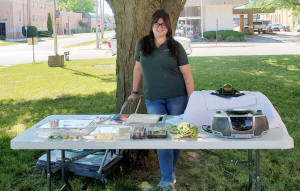 Cool,
ok, cold blooded things, make appearance at library Cool,
ok, cold blooded things, make appearance at library
 Send a link to a friend
Send a link to a friend
[July 06, 2022]
At the Lincoln Public Library’s summer reading program on Thursday,
June 30, kids learned about frogs and other amphibians.
|
|
 The presenter was Ms. Ashton of Rock Springs Nature
Center. The Nature Center is part of the Macon County Conservation
District in Decatur. Ms. Ashton is a naturalist who takes care of
animals at the center. The presenter was Ms. Ashton of Rock Springs Nature
Center. The Nature Center is part of the Macon County Conservation
District in Decatur. Ms. Ashton is a naturalist who takes care of
animals at the center.
Ashton first shared several facts about frogs. For example, frogs
are amphibians that lay eggs and are cold blooded. Like other
amphibians, frogs lose their gills and develop lungs for breathing
once they reach adulthood.
Frogs have been around for many years, since the age of the
dinosaur.
One interesting fact Ashton shared was that frogs do not sweat or
shiver but regulate their body temperature through the outside
world.
In the winter, frogs hibernate deep underwater in ponds or other
bodies of water. Some frogs even “freeze” during the winter, thawing
out once the temperatures are warmer and they come out of
hibernation.
Because frogs and toads have some similarities, Ashton explained the
differences and showed the kids their skeletons. Frogs have long and
skinny legs, live in water and are strong jumpers. Toads have short
legs, live on land and are not strong jumpers. Instead, they often
crawl around.
Frogs have pointy heads, which help them swim faster. They drink by
absorbing the water from ponds and other waterways through their
skin. Chemicals in yards can make them sick.
Other amphibians Ashton told the kids about were newts and
salamanders.
The state’s largest salamanders, called hellbenders, are endangered.
Ashton said that is because they need to live in clean water and
many waterways are not clean. Fortunately, zoos are doing programs
to help these salamanders.
Among frogs, Ashton said the largest in this state are bullfrogs.
The largest in the world are called Goliath bullfrogs.
To show the life cycle of frogs, Ashton brought plastic samples and
photos. She said frog eggs look a bit like Jello.
These eggs hatch into tadpole, which have gills but no lungs and
cannot breathe on land. The tadpoles have long tails which help them
quickly swim away from fish who might eat them.
Soon the tadpoles grow legs, lungs begin to develop, and their tails
get shorter.
The tadpoles then turn into froglets with four legs and a tiny tail.
Their lungs soon develop fully, and they can get on land.
Finally, the froglets turn into full grown frogs.
Ashton said the frogs are carnivores and eat algae, flies and
sometimes other frogs. As frogs eat, they blink their eyes to push
the food down.
Eardrums on the outside of frogs’ bodies help them hear.
To demonstrate the “music” of frogs, Ms. Ashton played a recording
of their sounds. She also showed everyone photos of which frog was
making the sound.
The sounds included six examples:
-
A Bullfrog with a low bass sound like the buzzing
of bees or a helicopter.
-
A Tree Frog with high pitch sounds like a bird.
-
A Spring Peeper with a high pitched “peep.”
-
A Northern Cricket Frog with a cricket like
sounds.
-
An American Toad with a trilling, vibrating
whistle sound.
-
A Fowler’s Toad with a screaming sound.
[to top of second column] |

To show the kids what the various amphibians she
cares for look like, Ms. Ashton brought four “friends.”
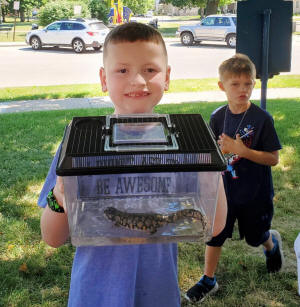
The first one was an Eastern Tiger Salamander. Ashton said they are
the state amphibian, but most live in captivity.
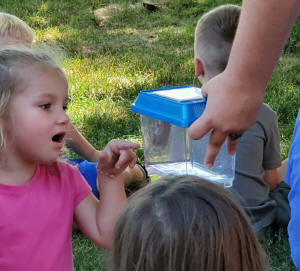
The second one was a Gray Tree Frog. Ashton said they have sticky
hands and feet.
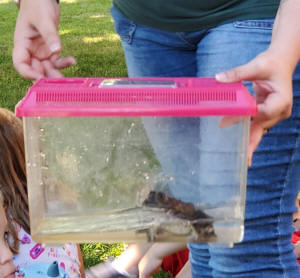
The third one was a Bullfrog. Ashton said the bullfrog sometimes
hops away from her at the nature center.
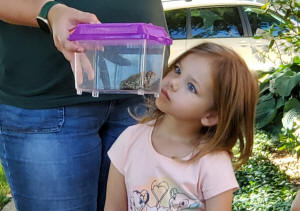
The fourth and final one was an American Toad with tan bumps. Ashton
said these are poison glands to protect the toad from being eaten.
As kids gathered round their little tanks to look at these
amphibians, Ms. Ashton reminded the kids not to touch the tanks.
These amphibians get scared easily.
The kids enjoyed seeing the amphibians and learning all the facts.
Next Thursday, July 7, Magician Richard Landry and his magic rabbit
'Snowball' will present “high energy comedy magic.”
[Angela Reiners]
 |